Article «What is a Scottish Fold?»
![]()
![]()
![]()
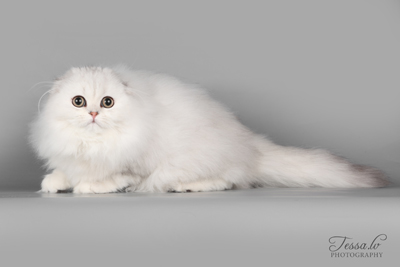 The Scottish Fold is a very special breed of cat. They are good "people" cats with a temperament that is generally sweet, bright and quiet with an easy-going nature. They require minimal care and are a real treasure to have in your home.
The Scottish Fold is a very special breed of cat. They are good "people" cats with a temperament that is generally sweet, bright and quiet with an easy-going nature. They require minimal care and are a real treasure to have in your home.
Scottish Fold history.
All pure-bred Scottish Folds can trace their lineage back to a white barn cat named Susie, the first folded-ear cat discovered in the Tayside Region of Perthshire, Scotland, in 1961 by the breed founders, William and Mary Ross.
After receiving one of Susie's folded-ear kittens and with the help of English genetists, the Rosses started a breeding program using British Shorthairs and farm cats. These cats were first called "lops" after the lop-eared rabbits, but in 1966 they were renamed "Scottish Folds" in honour of their origin. Brought over to the U.S. in the early 70s and registered in the Cat Fanciers' Association, the shorthair Scottish Fold was entitled to compete for championship status by the 1978-79 show season. The longhair Scottish Fold was not accepted for competition in CFA until 1993.
The Scottish Fold personality.
The Scottish Fold is a blend of other breeds: the British and American shorthairs. Both of these breeds are placid and calm, and usually agreeable to extended handling. Thus, the Fold has evolved as a sweet-tempered cat; devoted but not demanding; bouncy on occasion, but never too boisterous, more likely to charm than to challenge; displaying a British sense of decorum along with an American sense of self-confidence.
Breed characteristics.
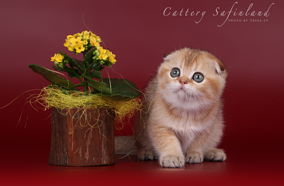 Breeding the Scottish Fold requires lots of patience and a special knowledge of proper breeding practices. First established by breeding to British Shorthairs and domestic cats, the Scottish Fold is now only allowed to be outcrossed with British and American Shorthairs and other Scottish Folds. This is necessary to enlarge the gene pool to produce health, vigour and soundness for the continuation of the breed.
Breeding the Scottish Fold requires lots of patience and a special knowledge of proper breeding practices. First established by breeding to British Shorthairs and domestic cats, the Scottish Fold is now only allowed to be outcrossed with British and American Shorthairs and other Scottish Folds. This is necessary to enlarge the gene pool to produce health, vigour and soundness for the continuation of the breed.
The characteristic ear-folding of the breed is caused by a spontaneous mutation, a fusion of the middle section of cartilage cells (mesodern) in the embryo. It is a incomplete dominant gene that must be present in one parent to pass on to offspring.
Breeding a folded-ear cat to a straight-ear (SE) cat ONLY is recommended. Breeding folded-ear cats together may cause complications such as cartilage mutation in the tail making it rigid and foreshortened, and stiffness or deformities in the hind legs and feet.
Scottish Fold kittens are not born with folded ears. The ears of the kittens that carry the gene start folding usually about the 21st day. The folding process begins by the crimping of the outer edge of the ear near the base, which gradually tightens with the ears tipping downward onto the head, giving the appearance that they are sliding off the top sides of the head. There are different types of ear folding: single fold; loose-in-back, tight-in-front; and tight, double, capped-to-the-head fold, which is the most desirable.
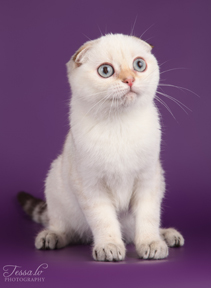 The following are standards that judges look for in this breed:
The following are standards that judges look for in this breed:
well-rounded head with a firm chin and jaw; prominent cheeks; muzzle to have well-rounded whisker pads, head blending into short neck; nose to be short with a gentle curve; profile is moderate in appearance
wide open eyes with a sweet expression, large, round and separated by a broad nose; eye colour corresponding with coat colour
ears to fold forward and downward; set in a cap-like fashion, smaller, tighter folded ear preferred
well-padded, medium size body and boning, legs in proportion to body; toes neat, well-rounded; five in front, four behind
tail medium to long in length, flexible, tapering, proportionate to the body
coat should be short to medium-short in length for shorthairs, dense, plush, even and full of life, medium-long to long in length for longhairs, britches, tail plume, toe tufts, and ear furnishings should be clearly visible with a ruff being desirable.
all colours are allowable
Choosing the right Scottish Fold for you:
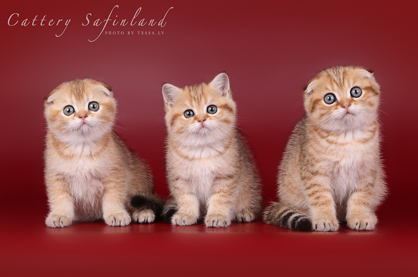
All Scottish Folds, whether folded ear or straight ear, make wonderful companions. If you decide that this breed is for you, be patient for it may take a while to find that right one due to the limited number of folded ear kittens in each litter.
Care and grooming will require weekly brushing; cleaning of ears, eyes and teeth; clipping of claws; an occasional bath with a good shampoo when needed; a well-balanced diet high in vitamins, minerals and protein; fresh water daily; adequate space for exercise in a clean, indoor environment; and most important, lots of love.
Producing sound, healthy kittens is the breeder's responsibility. But as the cat is a being of nature, certain factors may arise that are out of the breeder's control such as ears lifting or unfolding in warmer temperatures, during pregnancy or a heat cycle, or stiffness in the tail developing later on.
There is still a lot to learn about this breed, and to assure a future for the Scottish Fold, it is important that the breeder keep informed of any problems arising from kittens sold, eliminate problem cats from the breeding program, maintain sound breeding/cattery standards, and breed only straight to fold ear cats.
Before purchasing a Scottish Fold, contact several breeders to obtain as much information as possible. Ask for references and if they provide a sales agreement that includes genetic health and other guarantees. If possible, visit the breeder to view their cats, conditions and to discuss options; if not, find out if shipping is available to your local area. Know what and whom you are dealing with before signing any agreements, giving a deposit or full payment.
Once you have finally chosen and received that "right" Scottish Fold, properly introduce it gently into its new surroundings. Arrange for an immediate veterinarian's examination for your satisfaction. Never let your cat roam unattended outdoors and make sure it is altered at the appropriate age if not used in a responsible registered breeding program.
This information is compiled by The International Scottish Fold Association, and is a CFA affiliated breed club that promotes responsible ownership and breeding only straight-to-fold ear of registered, pedigreed Scottish Folds.
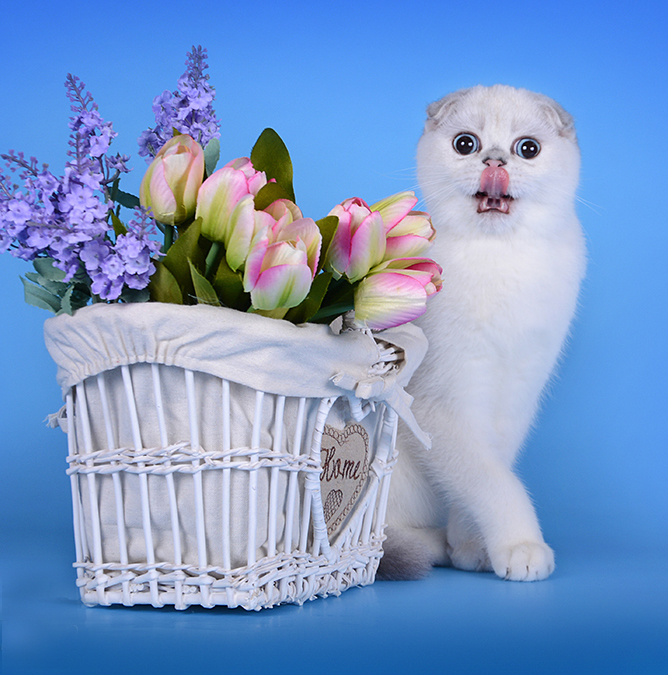 How Scottish Folds communicate.
How Scottish Folds communicate.
The Scottish Fold is, for the most part, not a talkative cat. Except when the females are in heat, Folds save their voices for certain occasions; like when they have been locked in a closet by accident, if you pull their fur too hard while grooming, or letting you know it's time to eat. Folds are known, for no other reason than the sheer joy of life, to jump into your lap with a cheerful greeting. Folds seldom talk just to admire the sound of their own voices; they usually have a definite reason for saying something, and it is up to the discerning owner to decipher each individual cat's message.
There are books on the market on how cats communicate, and what the different sounds might mean. However, you know your cat, and probably know exactly what they are saying, and thinking too. The most strange, yet endearing, verbal communication is the silent meow, not exclusive to the Fold, but still very common among them. They will open their mouth and mime the word meow, yet no sound emerges. Usually these "sounds" are a message of greeting, endearment, perhaps a complaint, or even simply "baying at the moon".


